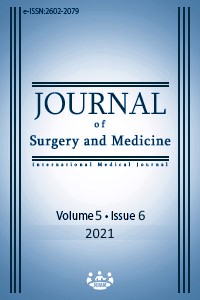Effects of preoperative and postoperative albumin levels on postoperative arrhythmias after open heart surgeries with cardiopulmonary bypass
Keywords:
Cardiopulmonary bypass, Ischemia-reperfusion injury, Arrhythmia, Sinus tachycardia, AlbuminAbstract
Background/Aim: Ischemia-reperfusion injury is associated with transient contractility disorders and lethal arrhythmias. The main reason for this is the increase in the oxidants and the decrease in the antioxidants. This study aimed to investigate the relationship between albumin, known to have antioxidant properties, and arrhythmias seen in the early postoperative period in patients undergoing open heart surgery. Methods: Adult patients undergoing open heart surgery with cardiopulmonary bypass within 5 years were included in this single-center, retrospective cohort study. The relationship of arrhythmias within the first 24 hours after the operation with the albumin levels obtained within 6 hours before the operation and within 4 hours after the operation was investigated. The difference between preoperative and postoperative albumin levels was evaluated using the Wilcoxon test and the relationship between albumin levels and arrhythmias, using the Mann-Whitney U test. The relationship between the results was evaluated by Pearson's correlation analysis, and the interaction of the results with correlations was evaluated by regression analysis. Results: A total of 56 patients were included in the study. The average age of the patients was 63.07 years (11.24) (range, 42-89). The mean preoperative and postoperative albumin levels were 4.04 (0.51) g/dL, and 3.21 (0.45) g/dL, respectively. The mean postoperative albumin level was significantly lower than the preoperative mean albumin level (P<0.001). In the analyses performed to find the relationship between albumin levels and postoperative arrhythmias, the effects of postoperative albumin levels on postoperative arrhythmias were significant (P=0.016). In the regression analysis, there was an interaction between postoperative albumin levels and preoperative albumin levels (P<0.001), postoperative arrhythmia status (P=0.005), postoperative sinus tachycardia status (P=0.002), and postoperative lactate levels (P=0.005). Conclusion: The present study suggests that high albumin levels may have a protective effect against postoperative arrhythmias. For all that, prospective studies may be planned with more patients and by examining the biochemical mechanism more comprehensively.
Downloads
References
Colantonio LD, Muntner P. It Is Time for Reducing Global Cardiovascular Mortality. Circulation 2019;140(9):726-8.
Argacha JF, Bourdrel T, van de Borne P. Ecology of the cardiovascular system: A focus on air-related environmental factors. Trends Cardiovasc Med. 2018;28(2):112-26.
Lee YS, Kim WY, Yoo JW, Jung HD, Min TJ. Correlation between regional tissue perfusion saturation and lactate level during cardiopulmonary bypass. Korean J Anesthesiol. 2018;71(2):361-7.
van Beek DEC, van der Horst ICC, de Geus AF, Mariani MA, Scheeren TWL. Albumin, a marker for post-operative myocardial damage in cardiac surgery. J Crit Care 2018;47:55-60.
Di Filippo C, Cervone C, Rossi C, di Ronza C, Marfella R, Capodanno P, et al. Antiarrhythmic effect of acute oxygen-ozone administration to rats. Eur J Pharmacol. 2010;629(1-3):89-95.
Dhalla NS, Elmoselhi AB, Hata T, Makino N. Status of myocardial antioxidants in ischemia–reperfusion injury. Cardiovasc Res. 2000;47(3):446-56.
Tural K, Ozden O, Bilgi Z, Kubat E, Ermutlu CS, Merhan O, et al. The protective effect of betanin and copper on heart and lung in end‑organ ischemia reperfusion injury. BratislLekListy. 2020;121(3):211-7.
Taghizadieh M, Hajipour B, Ahmadi Asl N, Khodadadi A, Somi MH, Banei M. Combination effect of melatonin and dexamethasone on liver ischemia/reperfusion injury. BratislLekListy. 2016;116(1):47-53.
Ahmed LA, Salem HA, Mawsouf MN, Attia AS, Agha AM. Cardioprotective effects of ozone oxidative preconditioning in an in vivo model of ischemia/reperfusion injury in rats. Scand J Clin Lab Invest. 2012;72(5):345-54.
Tsutsui H, Kinugawa S, Matsushima S. Oxidative stress and heart failure. Am J Physiol Heart Circ Physiol. 2011;301(6):2181-90.
Arques S. Human serum albumin in cardiovascular diseases. Eur J Intern Med. 2018;52:8-12.
Anraku M, Chuang VT, Maruyama T, Otagiri M. Redox properties of serum albumin. BiochimBiophysActa2013;1830(12):5465-72.
Kanko M, Yavuz S, Duman C, Hosten T, Oner E, Berki T. Ischemia-modified albumin use as a prognostic factor in coronary bypass surgery. J Cardiothorac Surg. 2012;7:3.
Eryılmaz R, Demir C, Aslan R, Demir H, Taken K.Can ischemia modified albumin (IMA) and total sulfhydryl level (TSH) be used as a biomarker in the diagnosis of bladder tumor? A prospective case-control study. J Surg Med. 2020;4(12):1104-7.
Zweier JL, Talukder MAH. The role of oxidants and free radicals in reperfusion injury. Cardiovasc Res. 2006;70(2):181-90.
Vandenbroucke JP, von Elm E, Altman DG, Gøtzsche PC, Mulrow CD, Pocock SJ, et al. Strengthening the Reporting of Observational Studies in Epidemiology (STROBE): explanation and elaboration. Epidemiology 2007;18(6):805-35.
De Lange F, Yoshitani K, Podgoreanu MV, Grocott HP, BurkhardMackensen G. A novel survival model of cardioplegic arrest and cardiopulmonary bypass in rats: a methodology paper. J Cardiothorac Surg. 2008;3:51.
Napoli P Di, Taccardi AA, Caterina R De, Barsotti A. Pathophysiology of ischemia-reperfusion injury: experimental data. Ital Heart J.2002;3(4):24-8.
Liao LZ, Zhang SZ, Li WD, Liu Y, Li JP, Zhuang XD, et al. Serum albumin and atrial fibrillation: insights from epidemiological and mendelian randomization studies. Eur J Epidemiol. 2020;35(2):113–22.
Zhu L, Chen M, Lin X. Serum albumin level for prediction of all-cause mortality in acute coronary syndrome patients: A meta-analysis. Biosci Rep.2020;40(1):1-8.
Kingeter A J, Raghunathan K, Munson SH, Hayashida DK, Zhang X, Iyengar S, et al. Association between albumin administration and survival in cardiac surgery: a retrospective cohort study. Can J Anesth. 2018:65(11):1218-27.
Arques S. Serum albumin and cardiovascular diseases: A comprehensive review of the literature. Ann CardiolAngeiol. 2018;67(2):82-90.
He YM, Yang XJ, Hui J, Jiang TB, Song JP, Liu ZH, et al. Low serum albumin levels in patients with paroxysmal atrial fibrillation: what does it mean? Acta Cardiol. 2006;61(3):333-7.
Downloads
- 421 561
Published
Issue
Section
How to Cite
License
Copyright (c) 2021 Kevser Tural, Ali Kahraman
This work is licensed under a Creative Commons Attribution-NonCommercial-NoDerivatives 4.0 International License.
















